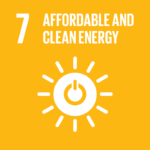Affordable and Clean Energy
Information and data related to energy distribution and access and the future of clean energy in South Africa

Affordable and Clean Energy
Information and data related to energy distribution and access and the future of clean energy in South Africa

Last updated: 25 February 2021 | Authors: Amelia Hilgart
The South African National Development Plan 2030 (NDP) includes an enabling milestones to:
Produce sufficient energy to support industry at competitive prices, ensuring access for poor households, while reducing carbon emissions per unit of power by about one-third.
In order to facilitate this, a priority infrastructure investment of ‘Procuring at least 20 000MW of renewable electricity by 2030, importing electricity from the region, decommissioning 11 000MW of ageing coal-fired power stations and stepping up investments in energy-efficiency’ was made. The current South African electric grid is dominated by coal production which generates 69% of national electricity with an additional 14% generated by crude oil and 11% generated through renewable energy (DoE, 2019). 52% of the total electricity consumption in South Africa comes from industrial use and 8% by domestic use.
Most South Africans access electricity through prepaid meters in their homes, however, access is not evenly distributed throughout the country with 76.6% of households in Umdoni Local Municipality without access and 0.3% of homes in Swellendam Local Municipality without access (StatsSA, 2016).
| Goal | ID | Indicator | Data | Dashboard |
|---|---|---|---|---|
| Goal 7 | 7.1.1 | Proportion of population with access to electricity | ||
| Goal 7 | 7.1.2 | Proportion of population with primary reliance on clean fuels and technology | coming soon | |
| Goal 7 | 7.1.2D | Percentage of the population that uses solar energy as their main source of energy | coming soon | |
| Goal 7 | 7.2.1 | Renewable energy share in the total final energy consumption | coming soon | |
| Goal 7 | 7.2.1A1 | Amount of renewable energy at annual operating capacity | coming soon | |
| Goal 7 | 7.2.1A2 | Annual amount of electricity produced from renewable sources | coming soon | |
| Goal 7 | 7.3.1 | Energy intensity measured in terms of primary energy and GDP | coming soon | |
| Goal 7 | 7.a.1 | International financial flows to developing countries in support of clean energy research and development and renewable energy production, including in hybrid systems | coming soon |